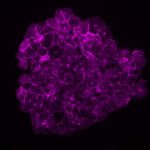Lien vers Pubmed [PMID] – 30641053
Lien DOI – S0016-5085(19)30031-910.1053/j.gastro.2019.01.010
Gastroenterology 2019 05; 156(6): 1788-1804.e13
Patients with cirrhosis are at high risk for hepatocellular carcinoma (HCC) and often have increased serum levels of estrogen. It is not clear how estrogen promotes hepatic growth. We investigated the effects of estrogen on hepatocyte proliferation during zebrafish development, liver regeneration, and carcinogenesis. We also studied human hepatocytes and liver tissues.Zebrafish were exposed to selective modifiers of estrogen signaling at larval and adult stages. Liver growth was assessed by gene expression, fluorescent imaging, and histologic analyses. We monitored liver regeneration after hepatocyte ablation and HCC development after administration of chemical carcinogens (dimethylbenzanthrazene). Proliferation of human hepatocytes was measured in a coculture system. We measured levels of G-protein-coupled estrogen receptor (GPER1) in HCC and nontumor liver tissues from 68 patients by immunohistochemistry.Exposure to 17β-estradiol (E2) increased proliferation of hepatocytes and liver volume and mass in larval and adult zebrafish. Chemical genetic and epistasis experiments showed that GPER1 mediates the effects of E2 via the phosphoinositide 3-kinase-protein kinase B-mechanistic target of rapamycin pathway: gper1-knockout and mtor-knockout zebrafish did not increase liver growth in response to E2. HCC samples from patients had increased levels of GPER1 compared with nontumor tissue samples; estrogen promoted proliferation of human primary hepatocytes. Estrogen accelerated hepatocarcinogenesis specifically in male zebrafish. Chemical inhibition or genetic loss of GPER1 significantly reduced tumor development in the zebrafish.In an analysis of zebrafish and human liver cells and tissues, we found GPER1 to be a hepatic estrogen sensor that regulates liver growth during development, regeneration, and tumorigenesis. Inhibitors of GPER1 might be developed for liver cancer prevention or treatment.The accession number in the Gene Expression Omnibus is GSE92544.


